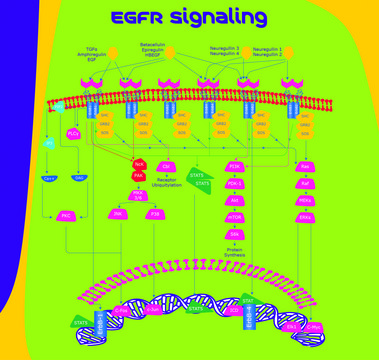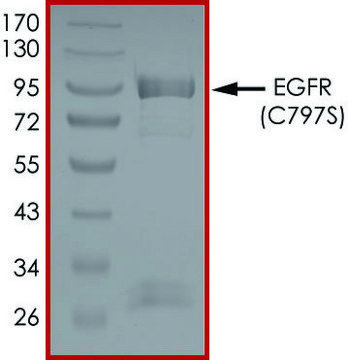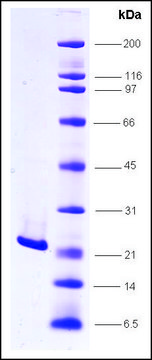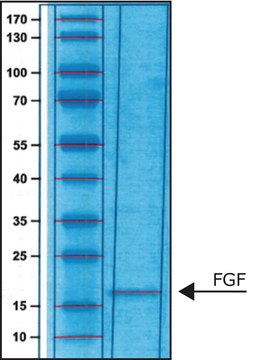SRP3239
GDNF from rat
recombinant, expressed in E. coli, ≥98% (SDS-PAGE), ≥98% (HPLC), suitable for cell culture
Sign Into View Organizational & Contract Pricing
All Photos(1)
Synonym(s):
ATF-1, Glial-Derived Neurotrophic Factor
UNSPSC Code:
12352202
NACRES:
NA.32
Recommended Products
biological source
rat
recombinant
expressed in E. coli
Assay
≥98% (HPLC)
≥98% (SDS-PAGE)
form
lyophilized
mol wt
15 kDa
packaging
pkg of 10 μg
technique(s)
cell culture | mammalian: suitable
impurities
<0.1 EU/μg endotoxin, tested
color
white to off-white
UniProt accession no.
shipped in
wet ice
storage temp.
−20°C
Gene Information
rat ... GDNF(25453)
Related Categories
General description
GDNF (glial cell derived neurotrophic factor) is a member of the transforming growth factor-β (TGF) superfamily. It is a potent neurotrophic factor which functions as a ligand for the multicomponent receptor complex containing GFRα1 (GDNF family receptor α1) and Ret receptor tyrosine kinase or neuronal cell adhesion molecule (NCAM). Rat GDNF is a homodimer linked by a disulfide bridge, and contains two glycosylated polypeptide chains that are released from the 211-residue-long precursor following a proteolytic cleavage.
The functional rat GDNF ligand is a disulfide-linked homodimer, of two 15.0kDa polypeptide chains called monomers. Each monomer contains seven conserved cysteine residues, one of which is used for inter-chain disulfide bridging and the others are involved in intramolecular ring formation known as the cysteine knot configuration.
The functional rat GDNF ligand is a disulfide-linked homodimer, of two 15.0kDa polypeptide chains called monomers. Each monomer contains seven conserved cysteine residues, one of which is used for inter-chain disulfide bridging and the others are involved in intramolecular ring formation known as the cysteine knot configuration.
Biochem/physiol Actions
GDNF (glial cell derived neurotrophic factor) enhances motoneuron survival, and facilitates the survival of midbrain dopaminergic neurons which are damaged in degenerative diseases, such as Parkinson′s. In vivo and in vitro, the interaction of this protein with GDNF family receptor α1 and its co-receptor Ret tyrosine kinase, results in elevated neurite extension and survival of motor and sensory neurons. In rats with neuropathic pain, the injection of this protein in the locus coeruleus (LC) produces prolonged analgesia by increasing descending noradrenergic inhibition.
Sequence
MSPDKQAAAL PRRERNRQAA AASPENSRGK GRRGQRGKNR GCVLTAIHLN VTDLGLGYET KEELIFRYCS GSCEAAETMY DKILKNLSRS RRLTSDKVGQ ACCRPVAFDD DLSFLDDSLV YHILRKHSAK RCGCI
Physical form
Lyophilized from 10 mM Sodium Citrate.
Reconstitution
Centrifuge the vial prior to opening. Reconstitute in water to a concentration of 0.1-1.0 mg/ml. Do not vortex. This solution can be stored at 2-8°C for up to 1 week. For extended storage, it is recommended to further dilute in a buffer containing a carrier protein (example 0.1% BSA) and store in working aliquots at -20°C to -80°C.
WGK
WGK 3
Flash Point(F)
Not applicable
Flash Point(C)
Not applicable
Regulatory Information
新产品
Certificates of Analysis (COA)
Search for Certificates of Analysis (COA) by entering the products Lot/Batch Number. Lot and Batch Numbers can be found on a product’s label following the words ‘Lot’ or ‘Batch’.
Already Own This Product?
Find documentation for the products that you have recently purchased in the Document Library.
Peripheral expression and biological activities of GDNF, a new neurotrophic factor for avian and mammalian peripheral neurons.
Trupp M et al
The Journal of Cell Biology, 130(1), 137-148 (1995)
Glial cell line-derived neurotrophic factor-mediated enhancement of noradrenergic descending inhibition in the locus coeruleus exerts prolonged analgesia in neuropathic pain.
Kimura M et al
British Journal of Pharmacology, 172(10), 2469-2478 (2015)
Finely Tuned Temporal and Spatial Delivery of GDNF Promotes Enhanced Nerve Regeneration in a Long Nerve Defect Model.
Marquardt LM et al
Tissue Engineering: Part A, 21(23-24), 2852-2864 (2015)
M Trupp et al.
Nature, 381(6585), 785-789 (1996-06-27)
Glial-cell-line-derived neutrophic factor (GDNF) promotes the survival and phenotype of central dopaminergic noradrenergic and motor neurons, as well as various subpopulations of peripheral sensory and sympathetic neurons. GDNF is structurally related to members of the transforming growth factor (TGF)-beta superfamily
L F Lin et al.
Science (New York, N.Y.), 260(5111), 1130-1132 (1993-05-21)
A potent neurotrophic factor that enhances survival of midbrain dopaminergic neurons was purified and cloned. Glial cell line-derived neurotrophic factor (GDNF) is a glycosylated, disulfide-bonded homodimer that is a distantly related member of the transforming growth factor-beta superfamily. In embryonic
Our team of scientists has experience in all areas of research including Life Science, Material Science, Chemical Synthesis, Chromatography, Analytical and many others.
Contact Technical Service



